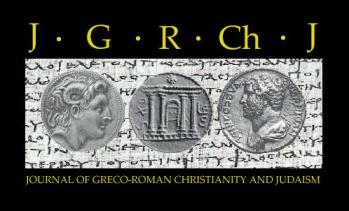2.1 | The Divine Benefactions of Paul the Client Zeba Crook Crook draws upon the categories of patronage and clientage within ancient
structures of benefaction to characterize Paul’s mission to the gentiles. Paul
characterizes his own calling in terms of being called by a divine patron. This
would have resonated with Paul’s audience at the time. He also describes his vision
of the risen Lord and apostleship in terms of divine benefaction. He reciprocates by
proclaiming a message of salvation. |
2.2 | 7Q5 = Mark 6.52-53: A Challenge for Textual Criticism? Hans Förster Förster draws upon procedure for publishing a papyrus in order to examine the
claims that 7Q5 is a fragment of Mark’s Gospel. He examines the claims made for this
identification but rejects them on the basis of the papyrus readings, the text in
Mark and the length of the lines. |
2.3 | Monotheistic Formulae of Belief in Greek Letters on Papyrus from the Second to
the Fourth Century Malcolm Choat and Alanna Nobbs Choat and Nobbs identify what they call ‘formulae of belief’ in Greek letters
from the second to the fourth century. On the basis of identifying these forms and
the frequency of their occurrence, they note what they call a monotheistic impulse
within the letters that is confirmed by other formulae found in the letters.
|
2.4 | The Tribulation in Revelation and Its Literary-Theological Milieu Galen K. Johnson Johnson identifies three bodies of ancient literature that are concerned with
great suffering before the end of the world—Jewish, Christian and the book of
Revelation—and compares how they treat who may expect to endure the tribulation,
what form the tribulation will take, the reason for the tribulation, how one endures
the tribulation, and, finally, the meaning of the millennium. |
2.5 | Boast Not in your Righteousness from the Law: A New Reading of Romans
10.6-8 Douglas C. Mohrmann Mohrmann offers a new reading of the use of Deuteronomy 30 in Rom. 10.6-8. He
contends that Paul creates ‘the-righteousness-from-faith’ as a substitute character,
attempting to win over the Jews to his gospel. The choice that is offered is between
a life guided by the law and faith in Christ. |
2.6 | The Concept of Atonement in Hellenistic Thought and 1 John Jintae Kim Kim surveys the use of ἱλασμός in Plutarch and 1 John in order to
determine whether the background for the concept of atonement is found in
non-Christian Greek sources. He concludes on the basis of the comparisons that the
background is instead to be found in Jewish sources of the time. |
2.7 | The Concept of Atonement in Early Rabbinic Thought and the New Testament
Writings Jintae Kim Kim surveys five different traditions in early rabbinic literature—the martyr
tradition, an atonement tradition, the death of exemplary figures, God’s chastising
the great, and some traditional sayings—and concludes that the there is continuity
between the Old Testament, Second Temple period and rabbinic writings regarding
atonement. He further notes that these traditions are in agreement with 1 John, even
though some distinctives remain. |
2.8 | ‘Let the Wife have Authority Over Her Husband’ (1 Corinthians 11.10) Craig Keener Keener understands the Greek term κεφαλή in 1 Cor. 11.3-7 to be
used to mean the wife’s husband and her own literal head. He then goes further and
suggests the possibility that Paul’s play on words continues in 1 Cor. 11.10, and
that he is saying that ‘the wife ought to have authority over her head [i.e. her
husband]’. |
2.9 | Participial Complementation in Roman and Byzantine Documentary Papyri:
ἐπίσταμαι, μανθάνω, εὑρίσκω Patrick James James examines participial complementation in Roman and Byzantine Greek
documentary papyri, and concludes that the participial construction persisted
because it was seen as an adjective. The accusative and infinitive construction was
marginalized by the emergence of the direct object. |
2.10 | How Noah, Jesus and Paul Became Captivating Biblical Figures: The Side Effects of
the Canonization of Slavery Metaphors in Jewish and Christian Texts Jesper Svartvik Svartvik examines the Old Testament and New Testament passages on slavery. As
a result, he notes that although Genesis 9 played an important role in pro-slavery
discourse, the rights granted slaves in the Hebrew Bible meant that the Hebrew Bible
was not used by the slavery movement. Similarly, the letters of Paul are seen by
Svartvik to be less clear on the issue of slavery than is the synoptic portrait of
Jesus. The parables, and especially Matthew’s teaching on eschatology, provided
support for the pro-slavery movement. |

